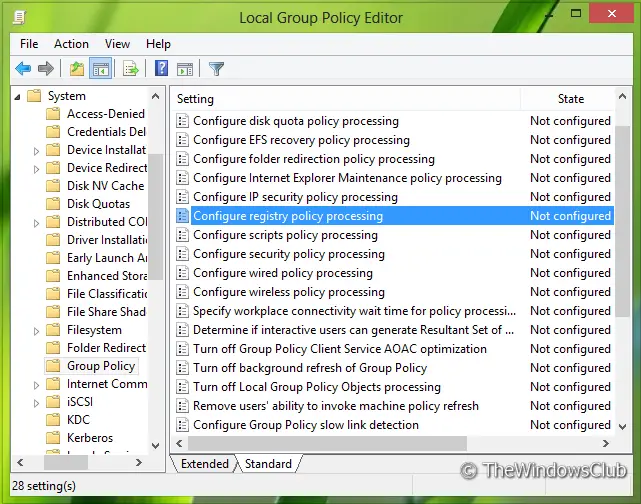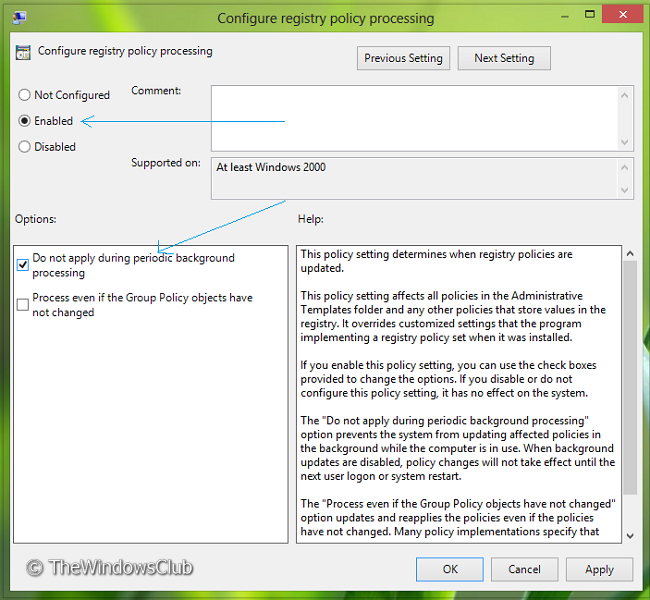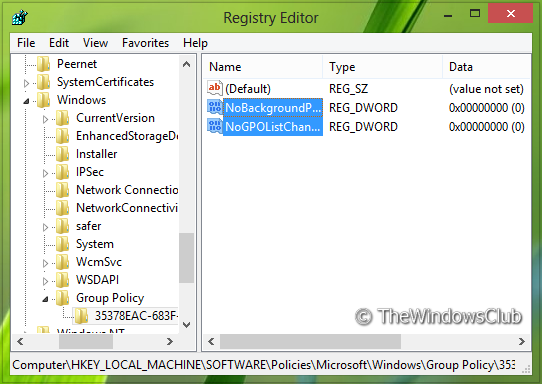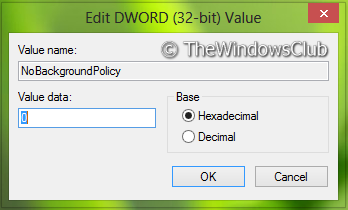You can disable background processing or Refresh the Registry Policy in Windows 11/10 while the computer is in use by modifying the Group Policy or Registry. Let us see how to do it in this post.
The Windows Registry is a hierarchical database that stores configuration settings and options on Microsoft Windows operating systems. It contains settings for low-level operating system components and the applications running on the platform. The registry uses the kernel, device drivers, services, SAM, user interface, and third-party applications.
The registry also provides a means to access counters for profiling system performance. By default, the registry manages its processing during an active session on the computer.
Registry Policy Processing
We have seen how to disable the background refresh of Group Policy. The Registry policy processing seems to share the same logic as the Group Policy. In either case, disabling the background refresh of registry processing prevents the system from updating affected policies while the computer is in use.
Also, for most users, this is fine; in some environments, system administrators may want to disable background refresh of the registry, and background updates can disrupt the user, cause a program to stop or operate abnormally, and, in rare cases, damage data.
Configure Background Refresh of Registry Policy Processing
- Press the Windows Key + R combination, type gpedit.msc in the Run dialog box, and Press Enter to open the Local Group Policy Editor.
- Navigate here:
Computer Configuration -> Administrative Templates -> System -> Group Policy

- Look for the setting Configure registry processing policy in the right pane. It should have a Not Configured status by default. Double-clicking over it will yield the following window:

- Click on the Enabled status to prevent registry processing while the computer is in use.
Additionally, you must check the option Do not apply during periodic background processing as indicated. Also, you can prevent the computer from updating the registry database even if the Group Policy is not changed by the Process even if the Group Policy objects have not changed option remains unchecked.
- Click Apply, followed by OK. Reboot to get results. That’s it!
Disable Background Refresh of Registry Processing using Registry Editor
- Press the Windows Key + R combination, type Regedt32.exe in the Run dialog box, and press Enter to open the Registry Editor.
- Navigate to this registry key:
HKLM\Software\Policies\Microsoft\Windows

- In the left pane of this location, create a new subkey using Right-click -> New -> Key over Windows key. Name it as Group Policy. Now, create a new subkey of the Group Policy subkey to be created similarly. Rename it as:
{35378EAC-683F-11D2-A89A-00C04FBBCFA2}
- To the right pane of the subkey created above, create a new DWORD using Right-click -> New -> DWORD.
- Name it as NoBackgroundPolicy, a replica of the Do not apply during periodic background processing option provided in Group Policy. Double-click on the DWORD to modify it:

- To prevent the computer from refreshing the registry in the background while in use, input the Value data equal to 1. Click OK. For the second option, similar to Group Policy, i.e. Process even if the Group Policy objects have not changed, you can create a new DWORD and name it NoGPOListChanges. Let its Value data remain 0.
- You may close the Registry Editor and reboot to see if the changes are effective.
That’s it!
How do I disable registry editing in Group Policy?
Navigate to User Configuration > Administrative Templates > System in Group Policy Editor. Double-click Prevent access to registry editing tools on the right and select Enabled. Click OK.
Does the registry override the Group policy?
Local policies have the lowest priority and can be overridden by domain policies applied later. However, local administrative rights allow for overriding individual Group Policy settings through the registry.
How can I tell if my husband is accessing my laptop from his work IP address????
He’s f**king this co-worker. She’s a beauty, so leave him alone.